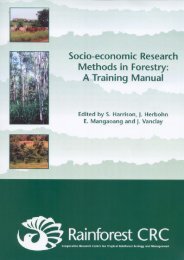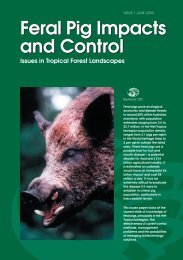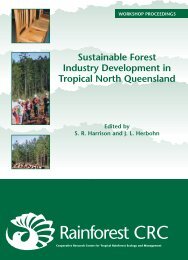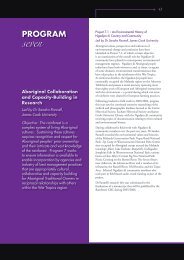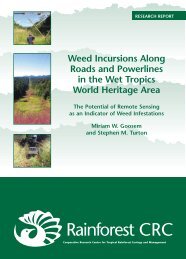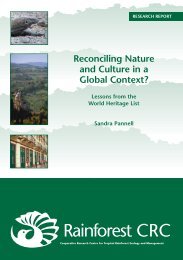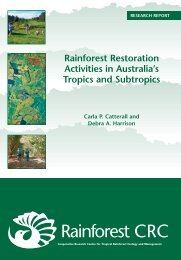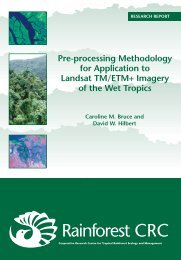Reconciling Nature and Culture in a Global Context? - Rainforest ...
Reconciling Nature and Culture in a Global Context? - Rainforest ...
Reconciling Nature and Culture in a Global Context? - Rainforest ...
You also want an ePaper? Increase the reach of your titles
YUMPU automatically turns print PDFs into web optimized ePapers that Google loves.
S<strong>and</strong>ra Pannellearth’s fauna <strong>and</strong> flora was subject to <strong>in</strong>creas<strong>in</strong>g scientific scrut<strong>in</strong>isation <strong>in</strong> an attempt to mapthe natural parameters of this bio-diverse world. As Katz po<strong>in</strong>ts out, the redef<strong>in</strong>ition of nature<strong>in</strong> terms of biodiversity not only set <strong>in</strong> motion a global program aimed at document<strong>in</strong>g theearth’s environmental riches but, as evidenced by UNESCO’s Biosphere Programme, it alsowent h<strong>and</strong>-<strong>in</strong>-h<strong>and</strong> with the reemergence of ideas about the preservation <strong>and</strong> restoration ofnature. What Katz calls the ‘new enclosure movement’ (1998: 47) entails sett<strong>in</strong>g aside‘discrete patches of nature’ (loc. cit.) <strong>in</strong> the form of ‘park enhancement districts’, ‘worldwildlife zones’, ‘biosphere reserves’, <strong>and</strong> so on. This strategy of ‘bio-accumulation’ <strong>and</strong> theidea of <strong>in</strong>vest<strong>in</strong>g <strong>in</strong> nature for the future also encouraged new forms of corporateenvironmentalism <strong>and</strong> the “<strong>in</strong>creas<strong>in</strong>g privatisation of public environments” (Katz 1998: 47).In Indonesia, nation-wide legislation specifically aimed at protect<strong>in</strong>g biodiversity was firstpassed <strong>in</strong> 1990 28 , while <strong>in</strong> Komodo National Park, Katz’s observations about the ‘privateproductions of space <strong>and</strong> the preservation of nature’ have been a reality for the past tenyears.In 1995, The <strong>Nature</strong> Conservancy (TNC), a US-based, transnational, private environmentalorganisation, jo<strong>in</strong>ed with the Indonesian National Park Authority PHKA 29 to ‘help’ manageKomodo National Park (Michael 2001: 35). TNC is the latest <strong>in</strong> a long list of <strong>in</strong>ternationalNon Government Organisations, <strong>in</strong>clud<strong>in</strong>g the World Wide Fund for <strong>Nature</strong> (WWF),Conservation International, <strong>and</strong> the Wildlife Conservation Society, to be <strong>in</strong>volved <strong>in</strong>management of the Park s<strong>in</strong>ce 1980. Promoted as the first example of ‘collaborative parkmanagement’ <strong>in</strong> Indonesia, TNC’s <strong>in</strong>volvement <strong>in</strong> Park management is justified by theorganisation <strong>in</strong> terms of its global mission to “preserve plants, animals <strong>and</strong> naturalcommunities that represent the diversity of life on earth by protect<strong>in</strong>g the l<strong>and</strong> <strong>and</strong> watersthey need to survive” (TNC 2002: 1). Through its multi-million dollar portfolio of propertiespurchased around the globe, <strong>and</strong> underwritten by corporate donations <strong>and</strong> <strong>in</strong>dividualcontributions, TNC operates “the largest private system of nature sanctuaries <strong>in</strong> the world”(cited <strong>in</strong> Katz 1998: 59). As Noel Grove observes, “to cut down on management <strong>and</strong>overhead costs, [TNC-owned] property was often turned over whenever possible toresponsible federal <strong>and</strong> state agencies for protection” (cited <strong>in</strong> Luke 1995: 14). In othersituations, TNC works with partner organisations to establish nature preserves or, as is thecase <strong>in</strong> Komodo National Park, ‘assists’ <strong>in</strong> sav<strong>in</strong>g “species <strong>and</strong> biotic communities that stood<strong>in</strong> danger of disappear<strong>in</strong>g under human pressures” <strong>in</strong> exist<strong>in</strong>g protected areas (see Luke1995: 14; Katz 1998: 59).While TNC presents its mission as ‘transnational’, conserv<strong>in</strong>g the biodiversity of Indonesia forthe “well-be<strong>in</strong>g of humank<strong>in</strong>d” (TNC 2002: 1), officials from the Indonesian Department ofAgriculture <strong>and</strong> Forestry cite a “lack of government funds” <strong>and</strong> the result<strong>in</strong>g “no or poor parkmanagement” as the primary reason for this new arrangement. Through the money itreceives from its donors, such as the Packard Foundation <strong>and</strong> Sekisui Chemical Company,TNC supposedly offers the Government of Indonesia a way out of their f<strong>in</strong>ancial dilemma,while at the same time ‘assist<strong>in</strong>g’ it with its conservation commitments 30 . In the case ofKomodo National Park, this marriage of private <strong>in</strong>terests, corporate funds <strong>and</strong> governmentresponsibility is formalised <strong>in</strong> a Memor<strong>and</strong>um of Underst<strong>and</strong><strong>in</strong>g between the parties, <strong>and</strong> isoperationalised <strong>in</strong> the name of a “pathbreak<strong>in</strong>g model for sav<strong>in</strong>g Indonesia’s national parks”(TNC 2005a), the ‘Komodo Co-Management Initiative’ (KCMI). In 2005, The <strong>Nature</strong>28 Law No. 5 of 1990 concern<strong>in</strong>g Conservation of Liv<strong>in</strong>g Resources <strong>and</strong> their Ecosystems.29 Management of national parks <strong>in</strong> Indonesia is the responsibility of the Director General for <strong>Nature</strong>Conservation <strong>and</strong> Forest Protection <strong>in</strong> the Department of Agriculture <strong>and</strong> Forestry (DirektoratJenderal Perl<strong>in</strong>dungan Hutan dan Konservasi Alam, Departemen Kehutanan dan Perkebunan).30 As reported <strong>in</strong> a World Bank publication, <strong>in</strong> 1996 TNC provided US $250,000 annually <strong>and</strong> “by<strong>in</strong>clud<strong>in</strong>g ecotourism <strong>and</strong> other <strong>in</strong>vestments, TNC expects to <strong>in</strong>vest US $5 million over the next fiveyears” (Wells et al. 1999: 27).30




